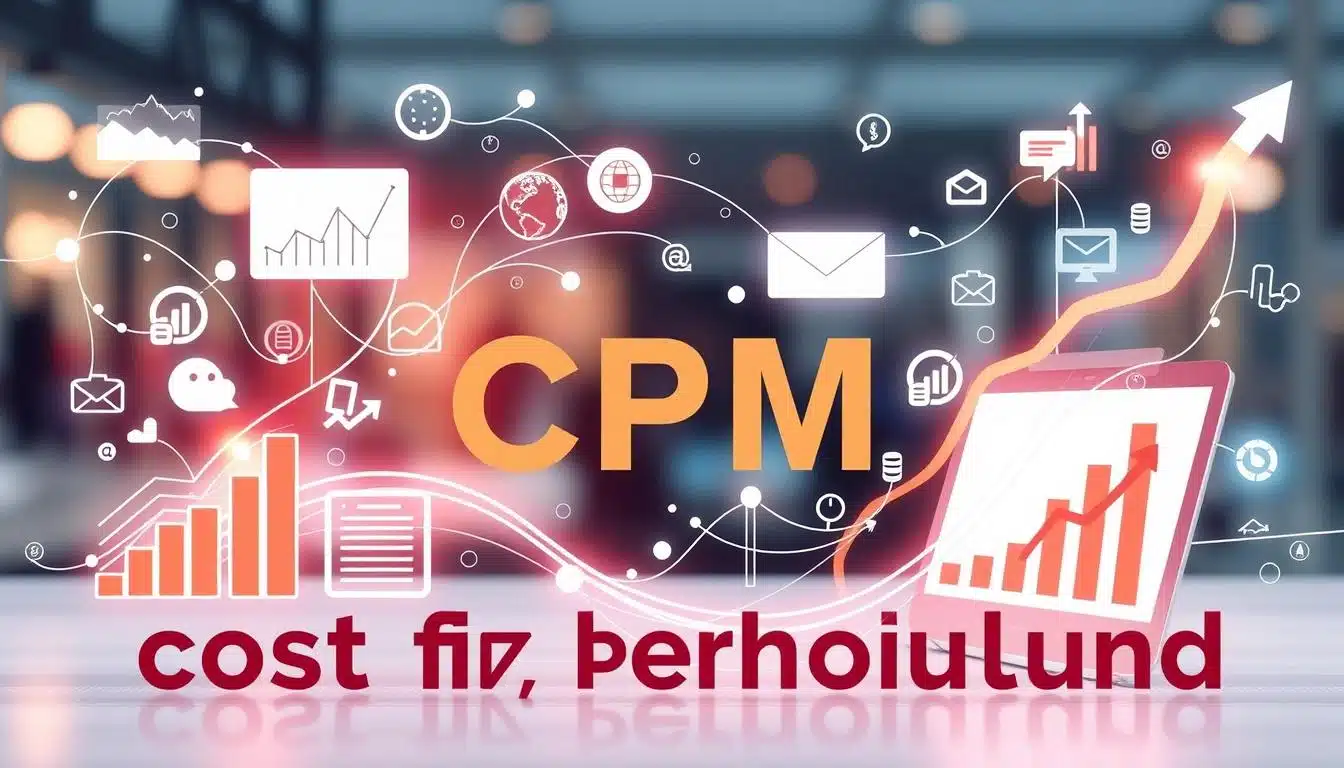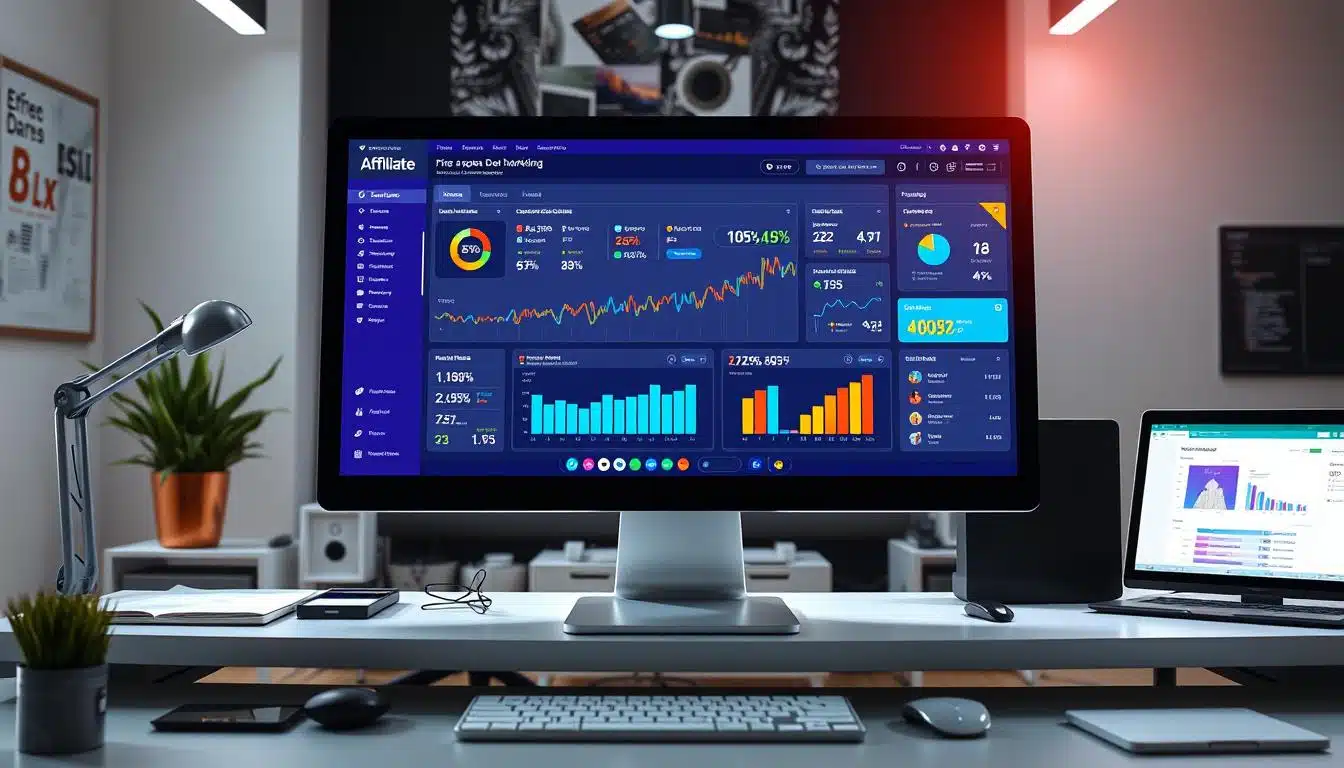In the digital advertising world, CPM, or cost per thousand impressions, is key. It’s the average cost an advertiser pays for 1,000 ad views. Each time a user sees the ad, it counts as one impression, even if they don’t click on it. Knowing about CPM is vital for digital marketers to measure and boost their ad campaigns.
Key Takeaways
- CPM, or cost per thousand impressions, is a common pricing model in digital advertising.
- CPM campaigns target thousands of people to build brand awareness and recognition.
- CPM is a cost-effective strategy that provides more impressions for less money compared to other marketing approaches.
- Tracking CPM can help identify anomalies and make adjustments to improve future advertising strategies.
- Successful CPM marketing requires understanding the metric, having a separate budget, and aligning with an overarching marketing strategy.
What Is CPM (Cost Per Thousand Impressions)?
In digital advertising, CPM, or cost per thousand impressions, is a common pricing model. It calculates the cost for every 1,000 times an ad is shown. An impression happens each time a user sees the ad, even if they don’t click it. CPM helps advertisers see how much they spend for a certain number of ad views.
Understanding Cost Per Thousand (CPM)
The CPM definition is simple: it’s what an advertiser pays for every 1,000 ad views. To figure out cost per mille, you use this formula: cost / impressions x 1,000. For instance, if a campaign costs $100 and gets 20,000 impressions, the CPM is $5 ($100 / 20,000 x 1,000).
The average online advertising cost per thousand impressions is between $3 and $10. A good CPM is usually under $3. To get a better cost per thousand impressions, advertisers should use optimization techniques. It’s also important to track other digital marketing metrics like click-through rate and conversion rate.
Putting ads in the right places is key to better CPM results. With over 5 billion internet users and 2.14 billion eCommerce shoppers worldwide, there’s a huge audience for CPM campaigns.
Impressions vs. Page Views
In the digital world, marketers often get confused between impressions and page views. These terms might seem alike, but they measure different things. They show how people interact with ads and content online.
Impressions count how many times an ad, like a banner or video, shows up on a page. It’s key for seeing how many people saw your ad. This tells you about your ad’s reach and visibility.
Page views, on the other hand, track how many times a page loads. It shows website traffic and engagement. But it doesn’t tell you about specific ad visibility.
Impressions and page views differ because they count in different ways. Impressions count at the ad level. Page views count at the page level. So, one page view can lead to many ad impressions, as users see multiple ads on one page.
| Metric | Description | Relevance for Advertisers |
|---|---|---|
| Impressions | The number of times an ad is displayed on a web page. | Impressions provide a direct measure of the visibility and reach of an ad campaign. |
| Page Views | The number of times a web page is loaded by users. | Page views offer insights into overall website traffic and engagement, but do not necessarily reflect the visibility of specific ads. |
Knowing the difference between impressions and page views is key for advertisers. It helps them see how well their ads are doing. By focusing on impressions, they can improve their ad placement and reach more people.
Click-Through Rate (CTR) and CPM
In the world of digital advertising, click-through rate (CTR) is key to understanding ad campaign success. CTR shows how many clicks an ad gets compared to how many times it’s seen. A high CTR means an ad is connecting well with its audience. A low CTR might mean it’s time to make some changes.
CTR works hand in hand with CPM (Cost Per Mille), which looks at the cost for every 1,000 ad views. By looking at both, marketers can see how well their ads are doing and if they’re worth the cost.
To figure out CTR, just divide the number of clicks by the number of times the ad was shown. Then, turn that number into a percentage. For instance, if an ad gets 50 clicks out of 1,000 views, its CTR is 5%.
CTR is very important for ads. A high CTR means an ad is hitting the right people, has interesting content, and is getting people to interact. On the other hand, a low CTR might mean the ad needs a refresh or better targeting.
“CTR is a critical metric for evaluating the success of digital advertising campaigns. It provides valuable insights into user behavior and helps marketers make data-driven decisions to improve the performance of their ads.”
By understanding click-through rate ctr, cpm vs ctr, and how to calculate ctr, marketers can make smart choices. They can work on improving their cpm vs ctr and boost the importance of ctr in advertising.
what does cpm stand for in advertising
In digital advertising, CPM means “cost per mille,” with “mille” being Latin for “thousand.” It’s the average cost an advertiser pays for 1,000 ad views. This model helps advertisers see how much they spend for ad visibility.
The CPM formula is easy: CPM = (Cost of campaign ÷ Total impressions) x 1,000. For example, if a campaign costs $500 and gets 100,000 views, the CPM is $5. This is because $500 ÷ 100,000 x 1,000 = $5.
| Metric | Definition | Calculation |
|---|---|---|
| CPM (Cost per Thousand Impressions) | The cost an advertiser pays for every 1,000 ad impressions | CPM = (Cost of campaign ÷ Total impressions) x 1,000 |
| CTR (Click-Through Rate) | The percentage of impressions that result in a click | CTR = (Number of clicks ÷ Number of impressions) x 100 |
CPM focuses on showing ads to many people, unlike CPC, which charges for each click. CPM doesn’t need user action, unlike CPA, which charges for actions like buying.
Many advertisers like CPM because it’s safe, easy, and doesn’t need extra work. It’s great for showing brands, reaching people, controlling costs, and working with retargeting.
Other Advertising Pricing Models
While the cost per thousand (CPM) model is well-known, there are other options. Marketers can look into pay-per-click (PPC) and cost-per-action (CPA) models. Each has its own strengths and fits different marketing goals.
Pay-Per-Click (PPC) Model
The PPC model, also known as cost-per-click (CPC), charges for each ad click. It’s great for grabbing attention and boosting website visits. Advertisers only pay when someone clicks their ad.
Cost-Per-Action (CPA) Model
The CPA model is all about specific actions, like conversions or leads. Advertisers pay a set fee for each action. It’s a good choice for campaigns that directly impact business goals, but it can be pricier.
These models can work together or as standalone options. Knowing the details of each helps marketers choose the best fit for their campaigns. This ensures their ads meet their goals effectively.
“Advertisers can benefit from a diversified approach, leveraging a combination of pricing models to optimize their campaigns and achieve their desired results.”
Calculating and Evaluating CPM
Finding the Cost Per Thousand (CPM) impressions is easy. Just divide the total ad campaign cost by the total impressions. Then, multiply by 1,000. This gives you the average cost per 1,000 ad views.
Whether a CPM rate is good depends on several things. These include the advertiser’s goals, the audience, and what’s common in the industry. A lower CPM means you can reach more people for less money. But, the quality of those views also matters.
Recent data shows the average CPM rates in the United States for different industries in 2023 are:
- Dating: $4.44
- Fashion & Apparel: $6.10
- Finance: $6.52
- Food Delivery: $7.63
- Home & Decor: $5.36
- Jobs: $4.93
- Media: $4.27
- Online Education: $5.66
- Pets: $6.10
- Retail: $5.39
- SaaS: $5.94
- Streaming Services: $6.00
- Travel: $7.12
By watching your CPM and comparing it to industry standards, you can improve your ads. This helps you get a better return on investment (ROI).
“Calculating and understanding CPM is key for marketers to make smart choices on where to place ads and how much to spend.”
Benefits of Using CPM
CPM (cost per thousand impressions) is a pricing model that offers many benefits. It’s cost-effective, allowing advertisers to reach lots of people without spending too much. This makes it a great choice for brands wanting to stretch their ad budget.
CPM also helps increase brand visibility and reach. Ads in CPM campaigns are seen by many users, exposing the brand to more people. This is super helpful for businesses aiming to grow their market and build awareness.
Lastly, CPM campaigns provide data and metrics that are super useful. By looking at how well ads perform, marketers can learn a lot. This knowledge helps improve lead generation and make future campaigns even better.
CPM is a key part of a solid marketing plan for any business. It’s all about being cost-effective, boosting brand visibility, and using data to improve marketing. This way, marketers can better connect with their audience, leading to more successful campaigns.
“CPM advertising is often less expensive compared to CPA or CPC promotion, making it a cost-effective option for businesses looking to maximize their advertising budget.”
Potential Drawbacks of CPM
The Cost Per Thousand Impressions (CPM) model has its benefits for advertisers. Yet, it also has some drawbacks that marketers should know about. One major concern is the quality of the traffic and impressions.
Advertisers pay for impressions, even if users aren’t interested. This can lead to low conversion rates and wasted money. Also, ad fraud and duplicate impressions can make CPM metrics less reliable. This makes it hard for advertisers to really see how well their campaigns are doing.
Another issue with CPM is ad blindness. Users might ignore ads because they see them too often. This can hurt the goals of CPM campaigns, like increasing brand awareness.
| Drawbacks of CPM | Explanation |
|---|---|
| Low Conversion Rates | Paying for impressions regardless of user engagement can lead to ads being served to uninterested users, resulting in low conversion rates. |
| Ad Fraud and Duplicate Impressions | Inaccurate CPM metrics due to ad fraud and duplicate impressions can make it challenging to evaluate campaign performance. |
| Ad Blindness | Constant exposure to ads can lead to users becoming desensitized and ignoring the ads, reducing their effectiveness. |
| Limited Control over Ad Placement | Advertisers have less control over where their ads are displayed, which can impact the relevance and effectiveness of the ads. |
| Inaccurate Targeting | Relying on impressions instead of user interactions can make it hard to target the right audience. |
To deal with these drawbacks of CPM, advertisers need to watch their campaigns closely. They should also work on better targeting and use fraud detection and analytics. This can help make CPM ads more effective and accurate.
Best Practices for CPM Campaigns
To get the most out of your CPM (cost-per-thousand impressions) ads, follow some key steps. These tips can help you optimize your CPM and boost your campaign’s success. This means better results for your business.
Clearly Define Business Goals
Start by setting clear goals for your CPM campaign. Do you want to boost brand awareness, get more website visitors, or find new leads? Having specific goals helps you focus your CPM strategy and ad placement.
Understand Your Target Audience
Knowing your audience is key to a good CPM campaign strategy. Study their demographics, interests, and behaviors. This helps you make ads that speak to your ideal customers, making your CPM spend more effective.
Monitor Campaign Performance
Keeping an eye on your campaign’s performance is vital for improving CPM. Check metrics like impressions, click-through rate (CTR), and conversions regularly. Use this info to tweak your targeting, ad copy, or formats. This way, you can optimize CPM and see better results.
“Successful CPM campaigns are the result of a well-defined strategy, deep audience insights, and a commitment to ongoing optimization.”
By sticking to these best practices for CPM campaigns, you can make your online ads more effective. This leads to more affordable brand exposure, better lead generation, and stronger marketing overall.
Conclusion
CPM in advertising is a key pricing model for digital marketers. It helps them reach and engage their audience effectively. Knowing what CPM is and how it works is essential for businesses to get the most out of their ads.
CPM rates are influenced by many factors. These include the industry, demographics, and the location of the audience. Understanding these can help marketers make better decisions and improve their campaigns.
Knowing CPM is vital for businesses to meet their marketing goals. It can help in building brand awareness, generating leads, and making smart decisions. By using CPM wisely, businesses can make their ads more effective and stay competitive online.
















Leave a Reply